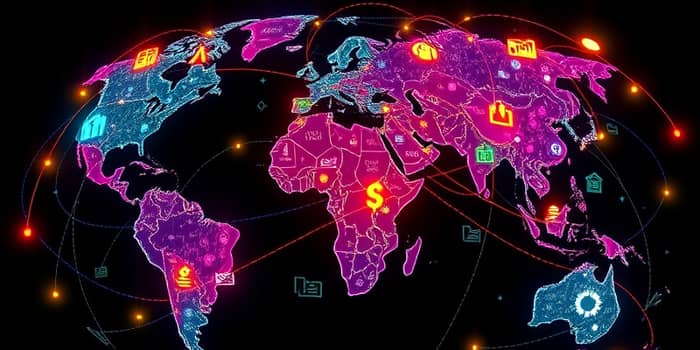
Financial markets around the world have become deeply entwined, shaping economies and influencing lives from New York to Nairobi. This article explores the complex network of financial ties that bind nations together, revealing both the opportunities and challenges of an ever-more connected global system.
The journey toward a unified financial landscape began centuries ago, as maritime trade routes linked empires and bullion flowed across continents. In the 19th century, the gold standard provided a rudimentary framework for cross-border exchange, while telegraph and steamship technologies laid the groundwork for rapid capital movements.
After World War II, institutions such as the International Monetary Fund and World Bank emerged to stabilize and reconstruct economies. The fall of the Bretton Woods system in 1971 ushered in true currency flexibility, sparking a wave of financial liberalization through the 1980s and 1990s.
Today’s markets link through multiple channels. Cross-border banking allows institutions to lend and borrow in dozens of jurisdictions, while sovereign and corporate bond markets raise funds globally.
Central counterparties clear vast volumes of derivatives and securities, creating capital flows, credit, investment, and risk sharing on an unprecedented scale. Technology underpins this pace, as high-frequency trading and digital payment systems enable transactions in microseconds.
Indirect channels amplify these connections. Investor sentiment can ripple from one region to another, and macroeconomic shocks in one country may trigger policy adjustments worldwide.
Global interconnectedness delivers tangible advantages:
When managed well, these benefits outweigh local constraints, fostering resilience against isolated downturns.
Interdependence also carries potential pitfalls. Shocks can traverse borders in days or hours, turning local crises into global upheavals. Market correlations tend to rise precisely when stability is most needed.
Understanding these vulnerabilities is crucial for policymakers and investors alike.
The 2007–08 crisis illustrates how a downturn in the U.S. housing market cascaded through securitized products to shake banks in Europe and Asia. Within weeks, credit markets froze globally, prompting synchronized central bank interventions.
During the COVID-19 pandemic, equity markets plummeted in unison as uncertainty surged. Simultaneously, massive coordinated global monetary and fiscal responses staved off deeper recessions, highlighting both the peril and promise of interconnected policy tools.
More recently, the collapse of a mid-sized bank in 2023 triggered cross-border equity sell-offs, underscoring how interlinked exposures—both direct and indirect—can lead to heightened volatility everywhere.
Effective oversight and cooperation are vital. Regulatory reforms since the global financial crisis have bolstered capital and liquidity standards, yet gaps remain. Policymakers must continue to adapt.
By strengthening international institutions and dialogue, authorities can better manage cross-border spillovers.
Looking forward, technological advances promise both deeper integration and new complexities. Digital currencies, distributed ledger systems, and emerging digital and nonbank finance models challenge traditional oversight.
Geopolitical shifts—driven by trade policy, climate action, and security concerns—may spur alternative payment rails and regional financial blocs, potentially fragmenting the global system.
Adaptive governance, continuous dialogue, and innovative risk-management tools will be key to navigating these dynamics without sacrificing the benefits of global capital mobility.
The global interconnectedness of financial markets is a double-edged sword that can amplify prosperity or peril. By understanding its mechanisms, acknowledging its risks, and collaborating across borders, we can harness its power to foster sustainable growth and stability.
Ultimately, balancing resilience with integration will determine whether this vast network remains a force for shared progress or becomes a conduit for collective shocks.
References













